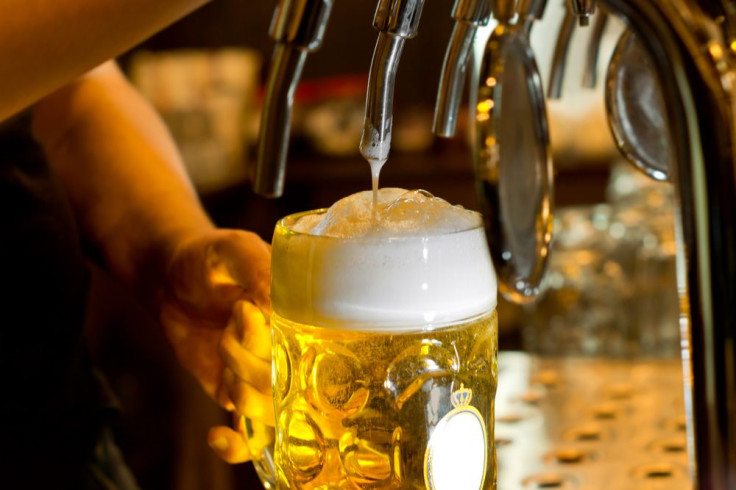Beer Glass Shape Alters How Fast We Drink Alcohol: Are You Drinking Too Much?

Grabbing a drink at the bar can progressively turn into two drinks, three drinks, and so on and so forth before your friends are even ready for the next round. You’ve reach the point of intoxication and start to think, am I drinking too much? The short answer: yes. According to two recent studies presented at the 2015 British Psychological Society Annual Conference, your beer glass shape, whether straight or curved, and its markings, influences your alcohol consumption rate.
"Excessive alcohol use is a major public health concern and there is a lot of interest in alcohol control strategies," said David Troy, a Ph.D. student at the University of Bristol, in a news release. "It is important to determine what environmental factors are contributing to excessive use and how they can be altered to nudge drinkers toward more responsible consumption."
In the U.S., binge drinking is the most common pattern of excessive alcohol use, says the National Institute on Alcohol Abuse and Alcoholism. Binge drinking is defined as a pattern of drinking that brings your blood alcohol concentration (BAC) to 0.08g/dL or more. This happens in men when they’ve had five or more drinks, and in women when they’ve had four or more drinks in a span of two hours. Despite this excessive behavior, most people who binge drink are not alcohol dependent.
Troy and Dr. Angela Attwood, both part of Bristol’s Tobacco and Alcohol Research Group, who presented the study, sought to observe the effects glass shape has in drinking behaviors. A total of 160 men and women, who were social drinkers with no history of alcohol problems, were split into two groups. One group was served beer in a curved glass that had markings showing measurements of a quarter, half, and three-quarters. The other group’s glasses were the same but had no marked volume measurements. The group with the marked glasses had a slower drinking rate of 10. Minutes compared to 9.1 minutes.
The researchers decided to test whether the effect of different shaped pint and half-pint glasses could be carried out in a “real-world” environment. Three public house — part of the Dawkins Ales — groups took part over two weekends. The findings revealed pubs using straight-sided glasses reported less alcohol consumption than drinking from curved glasses.
"It was a great opportunity to have three pubs willing to take part in the feasibility study. We now know it is feasible to conduct this type of research in real world situations and this will have implications for future research," Troy said. He did warn since only a limited number of pubs took part over a short time scale, "the results are preliminary and need to be treated with caution."
These findings echo a previous 2013 study published in the journal Substance Use & Misuse that found most people think a glass of wine is one serving, but in reality it could be two or three. The amount you pour is influenced by a variety of environmental factors, including glass shape, pouring position, and wine color. The participants poured 12 percent more wine into a wide glass than a standard one. This was also true when they were holding a glass while pouring compared to placing the glass on a table. This shows people have difficulty assessing volume, so this is why people drink less when they drink from a narrow glass, since they think they’re drinking more.
These studies conclude glass shape can lead to alcohol-related problems if not monitored correctly. Being mindful of glass shape and volume can possibly help curb binge drinking and lead heavy drinkers to consume alcohol at a slower pace, which is also part of the equation to slow intoxication.
"The speed at which beer is drunk can have a direct effect on the level of intoxication experienced. This can also increase how much is consumed in a single drinking session. While many people drink alcohol responsibly, it is not difficult to have 'one too many' and become intoxicated," said Attwood, in the news release.
Drinking at a slower pace can not only save your liver (and life), it’s also a cost-effective solution that can prevent alcohol intoxicated-related accidents.
Sources: Attwood AS, Hickman H, Munafò MR, and T DM. Shaping alcohol behavior change: It's in your hands. Oral presentation to the British Psychological Society Annual Conference. 2015.
Smarandescu L, Walker D, Wansink B. Half Full or Empty: Cues That Lead Wine Drinkers to Unintentionally Overpour. Substance Use & Misuse. 2014.



























